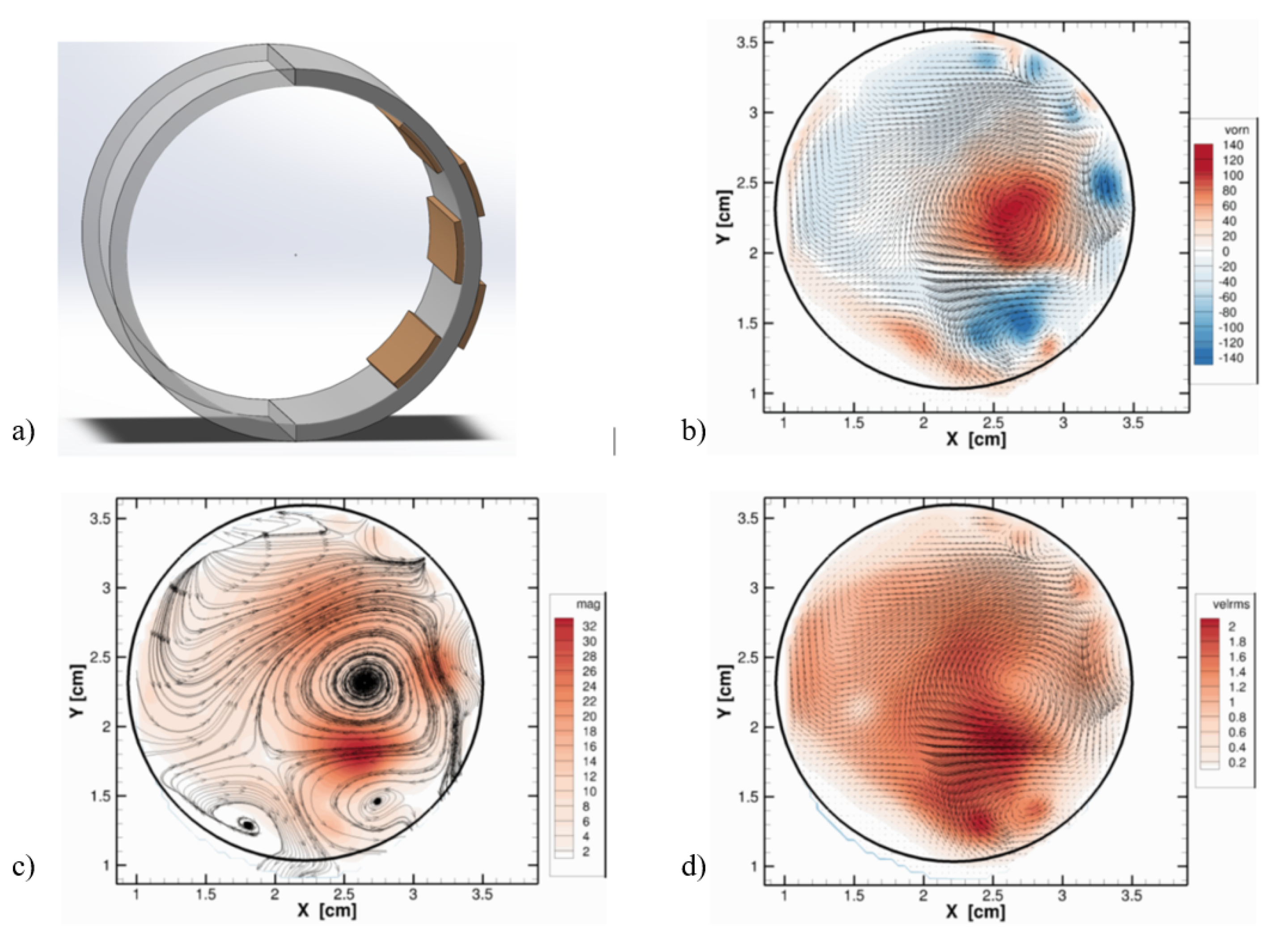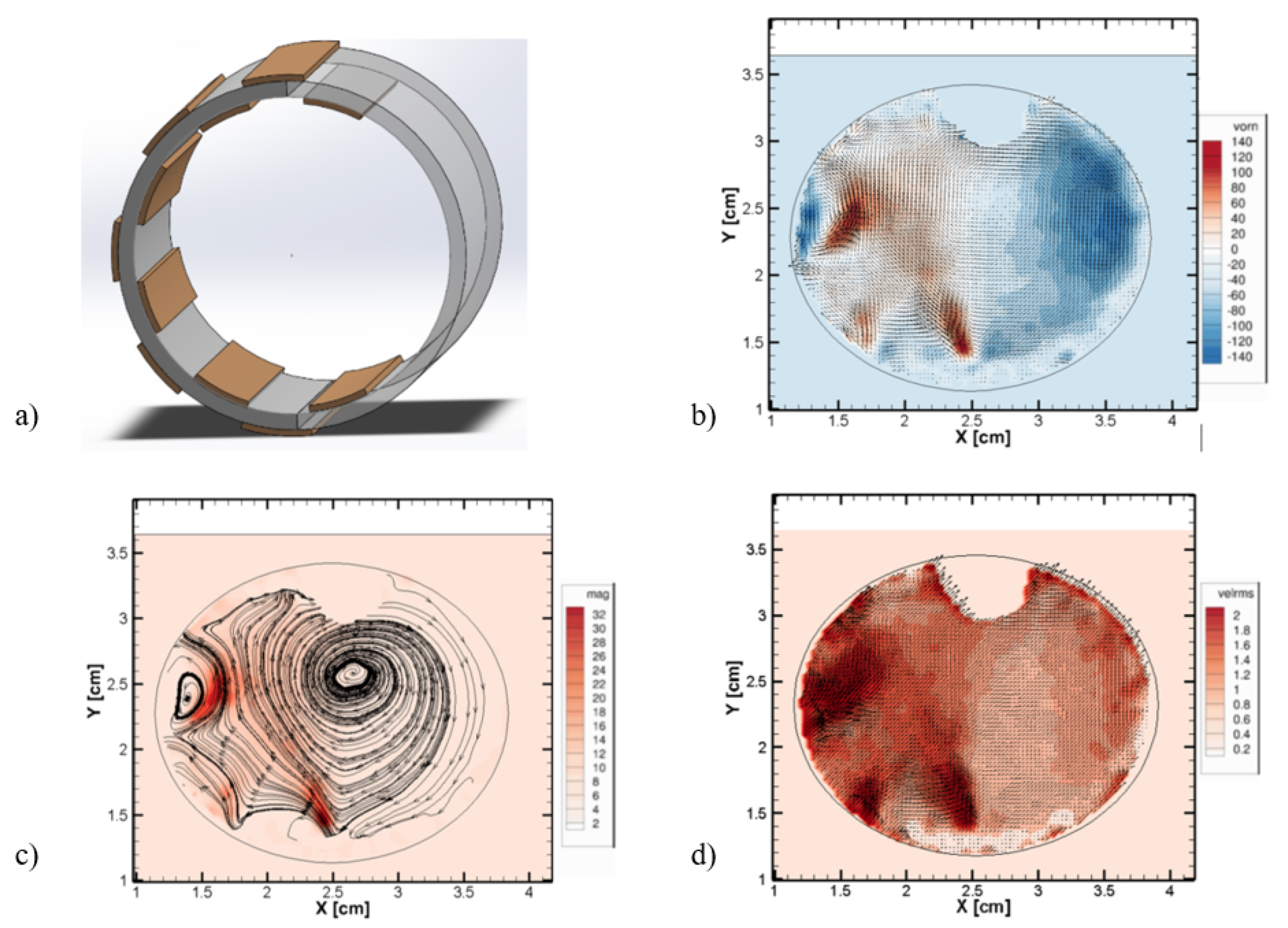Evaluation of Cylindrical Asymmetric Surface Dielectric Barrier Discharge Actuators for Surface Decontamination and Mixing
Abstract
:1. Introduction
2. Materials and Methods
2.1. Actuator Material and Design
2.2. Particle Image Velocimetry
2.3. Biological Experiment Setup
3. Results and Discussion
3.1. Particle Image Velocimetry
3.2. Bacterial Inactivation by Cylindrical SDBD Actuators
3.3. Assessment of Bacterial Inactivation by Cylindrical SDBD Actuators
4. Conclusions
Author Contributions
Funding
Data Availability Statement
Conflicts of Interest
Abbreviations
| ANOVA | Analysis of Variance |
| CAP | Cold Atmospheric Plasma |
| PIV | Particle Image Velocimetry |
| PWM | Pulse Width Modulation |
| RMS | Root Mean Squared |
| RONS | Reactive Oxygen and Nitrogen Species |
| SAS | Statistical Analysis System |
| SDBD | Surface Dielectric Barrier Discharge |
| VDBD | Volumetric Dielectric Barrier Discharge |
References
- Laroussi, M. Nonthermal decontamination of biological media by atmospheric-pressure plasmas: Review, analysis, and prospects. IEEE Trans. Plasma Sci. 2002, 30, 1409–1415. [Google Scholar] [CrossRef]
- Moisan, M.; Barbeau, J.; Moreau, S.; Pelletier, J.; Tabrizian, M.; Yahia, L. Low-temperature sterilization using gas plasmas: A review of the experiments and an analysis of the inactivation mechanisms. Int. J. Pharm. 2001, 226, 1–21. [Google Scholar] [CrossRef]
- Kong, M.G.; Kroesen, G.; Morfill, G.; Nosenko, T.; Shimizu, T.; van Dijk, J.; Zimmermann, J.L. Plasma medicine: An introductory review. New J. Phys. 2009, 11. [Google Scholar] [CrossRef]
- Moreau, E. Airflow control by non-thermal plasma actuators. J. Phys. D Appl. Phys. 2007, 40, 605–636. [Google Scholar] [CrossRef]
- Corke, T.C.; Enloe, C.L.; Wilkinson, S.P. Dielectric Barrier Discharge Plasma Actuators for Flow Control. Annu. Rev. Fluid Mech. 2010, 42, 505–529. [Google Scholar] [CrossRef]
- Laroussi, M.; Alexeff, I.; Kang, W.L. Biological Decontamination by Nonthermal. IEEE Trans. Plasma Sci. 2000, 28, 184–188. [Google Scholar] [CrossRef]
- Laroussi, M.; Leipold, F. Evaluation of the roles of reactive species, heat, and UV radiation in the inactivation of bacterial cells by air plasmas at atmospheric pressure. Int. J. Mass Spectrom. 2004, 233, 81–86. [Google Scholar] [CrossRef]
- Herrmann, H.W.; Henins, I.; Park, J.; Selwyn, G.S. Decontamination of chemical and biological warfare (CBW) agents using an atmospheric pressure plasma jet (APPJ). Phys. Plasmas 1999, 6, 2284–2289. [Google Scholar] [CrossRef] [Green Version]
- Boudam, M.K.; Moisan, M.; Saoudi, B.; Popovici, C.; Gherardi, N.; Massines, F. Bacterial spore inactivation by atmospheric-pressure plasmas in the presence or absence of UV photons as obtained with the same gas mixture. J. Phys. D Appl. Phys. 2006, 39, 3494–3507. [Google Scholar] [CrossRef]
- Timmons, C.; Pai, K.; Jacob, J.; Zhang, G.; Ma, L.M. Inactivation of Salmonella enterica, Shiga toxin-producing Escherichia coli, and Listeria monocytogenes by a novel surface discharge cold plasma design. Food Control 2018, 84, 455–462. [Google Scholar] [CrossRef]
- Pai, K.K.; Singarapu, K.; Jacob, J.D.; Madihally, S.V. Dose Dependent Selectivity and Response of Different Types of Mammalian Cells to Surface Dielectric Barrier Discharge (SDBD) Plasma. Plasma Process. Polym. 2015, 12, 666–677. [Google Scholar] [CrossRef]
- Ngo, A.; Pai, K.K.; Jacob, J.D. Investigation of Scaling Effects Due to Varying Dielectric Materials in Asymmetric Surface Dielectric Barrier Discharge. Aerosp. Res. Cent. 2017. [Google Scholar] [CrossRef]
- Pai, K.K. Asymmetric Surface Dielectric Barrier Discharge as a Novel Method for Biological Decontamination. Ph.D. Dissertation, Oklahoma State University, Stillwater, OK, USA, 2015. [Google Scholar]
- Pai, K.K.; Jacob, J.D. Evaluation of Dielectric Barrier Discharge Configurationsfor Biological Decontamination. Aerosp. Res. Cent. 2013. [Google Scholar] [CrossRef]
- Enloe, C.L.; McLaughlin, T.E.; VanDyken, R.D.; Kachner, K.D.; Jumper, E.J.; Corke, T.C. Mechanisms and Responses of a Single Dielectric Barrier Plasma Actuator: Plasma Morphology. AIAA J. 2004, 42, 589–594. [Google Scholar] [CrossRef]









Publisher’s Note: MDPI stays neutral with regard to jurisdictional claims in published maps and institutional affiliations. |
© 2021 by the authors. Licensee MDPI, Basel, Switzerland. This article is an open access article distributed under the terms and conditions of the Creative Commons Attribution (CC BY) license (https://creativecommons.org/licenses/by/4.0/).
Share and Cite
Ngo, A.D.; Pai, K.; Timmons, C.; Ma, L.M.; Jacob, J. Evaluation of Cylindrical Asymmetric Surface Dielectric Barrier Discharge Actuators for Surface Decontamination and Mixing. Plasma 2021, 4, 755-763. https://doi.org/10.3390/plasma4040038
Ngo AD, Pai K, Timmons C, Ma LM, Jacob J. Evaluation of Cylindrical Asymmetric Surface Dielectric Barrier Discharge Actuators for Surface Decontamination and Mixing. Plasma. 2021; 4(4):755-763. https://doi.org/10.3390/plasma4040038
Chicago/Turabian StyleNgo, Alvin D., Kedar Pai, Christopher Timmons, Li Maria Ma, and Jamey Jacob. 2021. "Evaluation of Cylindrical Asymmetric Surface Dielectric Barrier Discharge Actuators for Surface Decontamination and Mixing" Plasma 4, no. 4: 755-763. https://doi.org/10.3390/plasma4040038
APA StyleNgo, A. D., Pai, K., Timmons, C., Ma, L. M., & Jacob, J. (2021). Evaluation of Cylindrical Asymmetric Surface Dielectric Barrier Discharge Actuators for Surface Decontamination and Mixing. Plasma, 4(4), 755-763. https://doi.org/10.3390/plasma4040038





